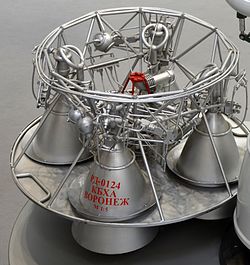RD-0124
 | |
| Country of origin | Russia |
|---|---|
| Date | 1993-2006 |
| First flight | 2006-12-27 |
| Designer | KBKhA (Chief designers: Valery Kozelkov, Viktor Gorokhov)[1] |
| Manufacturer | KBKhA in-house[2] |
| Application | Upper Stage |
| Associated LV | Soyuz-2 |
| Predecessor | RD-0110 |
| Status | In Production |
| Liquid-fuel engine | |
| Propellant | LOX / RG-1 |
| Cycle | Staged Combustion |
| Configuration | |
| Chamber | 4 |
| Performance | |
| Thrust, vacuum | 294.3 kN (66,200 lbf) |
| Thrust-to-weight ratio | 52.5 |
| Chamber pressure | 15.7 MPa (2,280 psi) |
| Specific impulse, vacuum | 359 s (3.52 km/s) |
| Burn time | 300 s |
| Dimensions | |
| Length | 1,575 mm (62.0 in) |
| Diameter | 2,400 mm (94 in) |
| Dry mass | 572 kg (1,261 lb) |
| Used in | |
| Soyuz-2-1b and Soyuz-2-1v Block-I | |
| References | |
| References | [3][4][5][6] |
The RD-0124 (GRAU Index 14D23) is a rocket engine burning liquid oxygen and kerosene in a staged combustion cycle. RD-0124 engines are used on the Soyuz-2.1b and Soyuz-2-1v. A slight variation of the engine, the RD-0124A, is used on the Angara rocket family URM-2 upper stage. RD-0124 is developed by Chemical Automatics Design Bureau.[3]
Design
RD-0124 engines use a multi-stage turbopump powered by pre-combustion of the engine propellants in the preburner. The kerosene fuel is used for regenerative cooling of the engine. Vehicle attitude control during ascent is provided by gimbaling the engine in two planes. The propellant tanks are helium-pressurized.[7] Four combustion chambers are fed by a single turbopump system.[7][8] The engine operates at a high chamber pressure and, for the type of propellants used, achieves a very high specific impulse.
History
The inaugural flight of a launch vehicle using an RD-0124 engine took place on December 27, 2006.[7] Orbital Sciences considered using the RD-0124 in the High Energy Second Stage (HESS) for their Antares rocket. It would have replaced the Castor 30B second stage.[9]
Versions
This upper stage engine has been adapted to two different launch vehicles, the Soyuz-2-1b/v and the Angara family. As such, there are different versions:
- RD-0124 (GRAU Index 14D23). It is the version for the Soyuz-2-1b and Soyuz-2-1v Blok-I. It is the first liquid rocket engine designed in Russia after the Soviet period.[3]
- RD-0124A. It is the version that powers the Angara URM-2, both the 1.2 and the bigger 5 versions. It differs on the base model in having an extended burn time of 424 seconds and, at 548 kg (1,208 lb), being 24 kg (53 lb) lighter.[3]
- RD-0124DR. Version developed between 2008 and 2013 for the Soyuz-2-3 project. It would differ from the base version in the implementation of a throttled point of 176.6 kN (39,700 lbf) with a reduced chamber pressure of 9.5 MPa (1,380 psi) and a specific impulse of 347s. The throttling capability meant a redesign of the preburner and the combustion chamber.[10]
- RD-0125A. Single nozzle version of the RD-0124A, it is planned as an upgrade for the Angara URM-2. It would enable the use of dual engines, which would enhance performance and reduce launch cost. Probably only planned for the Angara-5 URM-2, which is bigger than the Angara-1.2's.[11]
See also
- RD-0110 — previous engine.
- Soyuz-2-1b — first launch vehicle to use it.
- Soyuz-2-1v — second launch vehicle to use it.
- Angara — third launch vehicle to use it.
- Comparison of orbital rocket engines
References
- ^ ru:Горохов, Виктор Дмитриевич Viktor Gorokhov / ru.wikipedia.org
- ^ Люди и ракетные двигатели [People and Rocket Engines: Official History of KBKhA] (in Russian). p. 262.
- ^ a b c d "RD0124 (14D23). Launch vehicle "Soyuz-2-1б". RD0124A. "Angara" launch vehicle". KBKhA. Retrieved 2015-07-22.
- ^ "Turbopumps for Gas Generator and Staged Combustion Cycle Rocket Engines" (PDF). AIAA. July 2005. Retrieved 2015-07-22.
- ^ "Жидкостный ракетный двигатель РД-0124А" [Liquid rocket engine RD-0124A] (in Russian). Khrunichev. Retrieved 2015-07-22.
- ^ Zak, Anatoly. "RD-0110". russianspaceweb.com. Retrieved 2015-07-22.
- ^ a b c "The Modernized Soyuz". Starsem.
- ^ "Soyuz Overview". Arianespace. Retrieved 2015-07-22.
- ^ Bergin, Chris (2013-03-05). "CASTOR 30XL prepares for static fire ahead of providing Antares boost". NASA Spaceflight. Retrieved 2015-07-22.
- ^ "Двигатель РД0124ДР (дросселированный)" [Engine RD0124DR (throttled)] (in Russian). KBKhA. Retrieved 2015-07-22.
- ^ "Двигатель РД0125А" [Engine RD0125A] (in Russian). KBKhA. Retrieved 2015-07-22.

